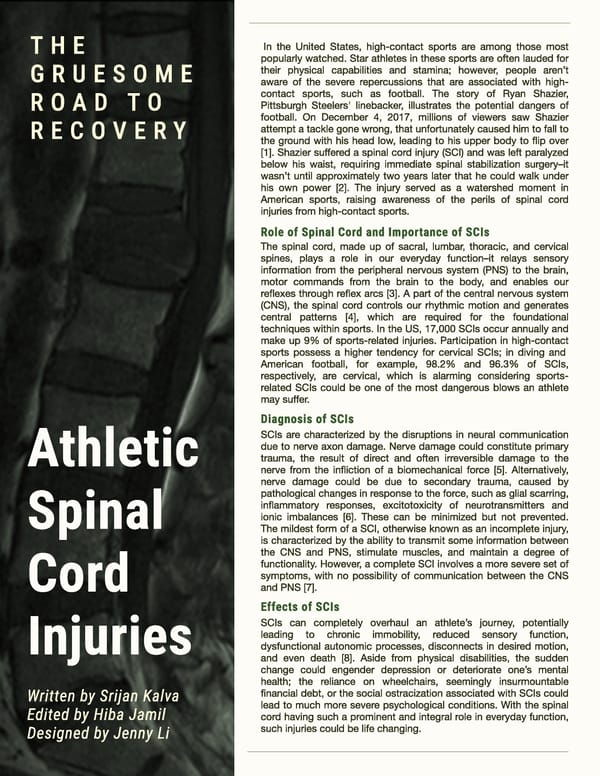In the United States, high-contact sports are among those most T h e popularly watched. Star athletes in these sports are often lauded for their physical capabilities and stamina; however, people aren’t G r u e s o m e aware of the severe repercussions that are associated with high- contact sports, such as football. The story of Ryan Shazier, Pittsburgh Steelers' linebacker, illustrates the potential dangers of R o a d t o football. On December 4, 2017, millions of viewers saw Shazier attempt a tackle gone wrong, that unfortunately caused him to fall to R e c o v e r y the ground with his head low, leading to his upper body to 昀氀ip over [1]. Shazier su昀昀ered a spinal cord injury (SCI) and was left paralyzed below his waist, requiring immediate spinal stabilization surgery–it wasn’t until approximately two years later that he could walk under his own power [2]. The injury served as a watershed moment in American sports, raising awareness of the perils of spinal cord injuries from high-contact sports㠀᐀ Role of Spinal Cord and Importance of SCIs The spinal cord, made up of sacral, lumbar, thoracic, and cervical spines, plays a role in our everyday function–it relays sensory information from the peripheral nervous system (PNS) to the brain, motor commands from the brain to the body, and enables our re昀氀exes through re昀氀ex arcs [3]. A part of the central nervous system (CNS), the spinal cord controls our rhythmic motion and generates central patterns [4], which are required for the foundational techniques within sports. In the US, 17,000 SCIs occur annually and make up 9% of sports-related injuries. Participation in high-contact sports possess a higher tendency for cervical SCIs; in diving and American football, for example, 98.2% and 96.3% of SCIs, respectively, are cervical, which is alarming considering sports- related SCIs could be one of the most dangerous blows an athlete may su昀昀er㠀᐀ Diagnosis of SCIs SCIs are characterized by the disruptions in neural communication due to nerve axon damage. Nerve damage could constitute primary trauma, the result of direct and often irreversible damage to the Athletic nerve from the in昀氀iction of a biomechanical force [5]. Alternatively, nerve damage could be due to secondary trauma, caused by pathological changes in response to the force, such as glial scarring, in昀氀ammatory responses, excitotoxicity of neurotransmitters and ionic imbalances [6]. These can be minimized but not prevented. Spinal The mildest form of a SCI, otherwise known as an incomplete injury, is characterized by the ability to transmit some information between the CNS and PNS, stimulate muscles, and maintain a degree of functionality. However, a complete SCI involves a more severe set of symptoms, with no possibility of communication between the CNS and PNS [7]㠀᐀ Cord Effects of SCIs SCIs can completely overhaul an athlete’s journey, potentially leading to chronic immobility, reduced sensory function, dysfunctional autonomic processes, disconnects in desired motion, Injuries and even death [8]. Aside from physical disabilities, the sudden change could engender depression or deteriorate one’s mental health; the reliance on wheelchairs, seemingly insurmountable 昀椀nancial debt, or the social ostracization associated with SCIs could Written by Srijan Kalv愀 lead to much more severe psychological conditions. With the spinal Edited by Hiba Jami氀 cord having such a prominent and integral role in everyday function, such injuries could be life changing.⠀䠀 Designed by Jenny Li
 Penn Healthcare Review Fall 2023 Journal— Sports Medicine Page 27 Page 29
Penn Healthcare Review Fall 2023 Journal— Sports Medicine Page 27 Page 29